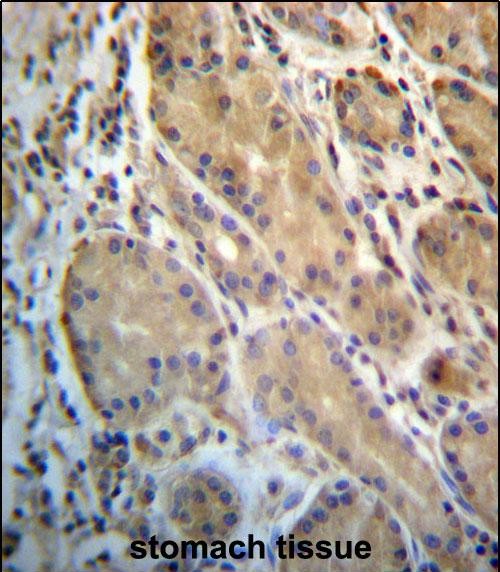ERO1L Antibody (C-term)
Affinity Purified Rabbit Polyclonal Antibody (Pab)
- SPECIFICATION
- CITATIONS
- PROTOCOLS
- BACKGROUND

Application
| IHC-P, WB, E |
|---|---|
| Primary Accession | Q96HE7 |
| Other Accession | NP_055399.1 |
| Reactivity | Human |
| Host | Rabbit |
| Clonality | Polyclonal |
| Isotype | Rabbit IgG |
| Calculated MW | 54393 Da |
| Antigen Region | 350-379 aa |
| Gene ID | 30001 |
|---|---|
| Other Names | ERO1-like protein alpha, ERO1-L, ERO1-L-alpha, 184-, Endoplasmic oxidoreductin-1-like protein, Oxidoreductin-1-L-alpha, ERO1L |
| Target/Specificity | This ERO1L antibody is generated from rabbits immunized with a KLH conjugated synthetic peptide between 350-379 amino acids from the C-terminal region of human ERO1L. |
| Dilution | WB~~1:1000 IHC-P~~1:10~50 |
| Format | Purified polyclonal antibody supplied in PBS with 0.09% (W/V) sodium azide. This antibody is purified through a protein A column, followed by peptide affinity purification. |
| Storage | Maintain refrigerated at 2-8°C for up to 2 weeks. For long term storage store at -20°C in small aliquots to prevent freeze-thaw cycles. |
| Precautions | ERO1L Antibody (C-term) is for research use only and not for use in diagnostic or therapeutic procedures. |
| Name | ERO1A (HGNC:13280) |
|---|---|
| Synonyms | ERO1L |
| Function | Oxidoreductase involved in disulfide bond formation in the endoplasmic reticulum. Efficiently reoxidizes P4HB/PDI, the enzyme catalyzing protein disulfide formation, in order to allow P4HB to sustain additional rounds of disulfide formation. Following P4HB reoxidation, passes its electrons to molecular oxygen via FAD, leading to the production of reactive oxygen species (ROS) in the cell. Required for the proper folding of immunoglobulins (PubMed:29858230). Plays an important role in ER stress-induced, CHOP-dependent apoptosis by activating the inositol 1,4,5-trisphosphate receptor IP3R1. Involved in the release of the unfolded cholera toxin from reduced P4HB/PDI in case of infection by V.cholerae, thereby playing a role in retrotranslocation of the toxin. |
| Cellular Location | Endoplasmic reticulum membrane; Peripheral membrane protein; Lumenal side. Golgi apparatus lumen. Secreted. Cell projection, dendrite {ECO:0000250|UniProtKB:Q8R4A1}. Note=The association with ERP44 is essential for its retention in the endoplasmic reticulum (PubMed:29858230). In neurons, it localizes to dendrites (By similarity). {ECO:0000250|UniProtKB:Q8R4A1, ECO:0000269|PubMed:29858230} |
| Tissue Location | Widely expressed at low level. Expressed at high level in upper digestive tract. Highly expressed in esophagus. Weakly expressed in stomach and duodenum. |

Thousands of laboratories across the world have published research that depended on the performance of antibodies from Abcepta to advance their research. Check out links to articles that cite our products in major peer-reviewed journals, organized by research category.
info@abcepta.com, and receive a free "I Love Antibodies" mug.
Provided below are standard protocols that you may find useful for product applications.
Background
Essential oxidoreductase that oxidizes proteins in the endoplasmic reticulum to produce disulfide bonds. Acts by oxidizing directly P4HB/PDI isomerase through a direct disulfide exchange. Does not act as a direct oxidant of folding substrate, but relies on P4HB/PDI to transfer oxidizing equivalent. Associates with ERP44 but not with GRP54, demonstrating that it does not oxidize all PDI related proteins and can discriminate between PDI and related proteins. Its reoxidation probably involves electron transfer to molecular oxygen via FAD. Acts independently of glutathione. May be responsible for a significant proportion of reactive oxygen species (ROS) in the cell, thereby being a source of oxidative stress. Required for the folding of immunoglobulin proteins. Responsible for the release of the unfolded cholera toxin from reduced P4HB/PDI in case of infection by V.cholerae, thereby playing a role in retrotranslocation of the toxin.
References
Inaba, K., et al. EMBO J. 29(19):3330-3343(2010)
Appenzeller-Herzog, C., et al. EMBO J. 29(19):3318-3329(2010)
Swiatkowska, M., et al. J. Biol. Chem. 285(39):29874-29883(2010)
Chambers, J.E., et al. J. Biol. Chem. 285(38):29200-29207(2010)
Rose, J.E., et al. Mol. Med. 16 (7-8), 247-253 (2010) :
If you have used an Abcepta product and would like to share how it has performed, please click on the "Submit Review" button and provide the requested information. Our staff will examine and post your review and contact you if needed.
If you have any additional inquiries please email technical services at tech@abcepta.com.














 Foundational characteristics of cancer include proliferation, angiogenesis, migration, evasion of apoptosis, and cellular immortality. Find key markers for these cellular processes and antibodies to detect them.
Foundational characteristics of cancer include proliferation, angiogenesis, migration, evasion of apoptosis, and cellular immortality. Find key markers for these cellular processes and antibodies to detect them. The SUMOplot™ Analysis Program predicts and scores sumoylation sites in your protein. SUMOylation is a post-translational modification involved in various cellular processes, such as nuclear-cytosolic transport, transcriptional regulation, apoptosis, protein stability, response to stress, and progression through the cell cycle.
The SUMOplot™ Analysis Program predicts and scores sumoylation sites in your protein. SUMOylation is a post-translational modification involved in various cellular processes, such as nuclear-cytosolic transport, transcriptional regulation, apoptosis, protein stability, response to stress, and progression through the cell cycle. The Autophagy Receptor Motif Plotter predicts and scores autophagy receptor binding sites in your protein. Identifying proteins connected to this pathway is critical to understanding the role of autophagy in physiological as well as pathological processes such as development, differentiation, neurodegenerative diseases, stress, infection, and cancer.
The Autophagy Receptor Motif Plotter predicts and scores autophagy receptor binding sites in your protein. Identifying proteins connected to this pathway is critical to understanding the role of autophagy in physiological as well as pathological processes such as development, differentiation, neurodegenerative diseases, stress, infection, and cancer.



